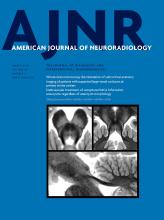Index by author
Graham, M.E.
- Pediatric NeuroimagingYou have accessInfant Midnasal Stenosis: Reliability of Nasal MetricsM.E. Graham, K.M. Loveridge, S.H. Pollard, K.R. Moore and J.R. SkirkoAmerican Journal of Neuroradiology March 2019, 40 (3) 562-567; DOI: https://doi.org/10.3174/ajnr.A5980
Grill, J.
- Pediatric NeuroimagingYou have accessEvaluation of the Implementation of the Response Assessment in Neuro-Oncology Criteria in the HERBY Trial of Pediatric Patients with Newly Diagnosed High-Grade GliomasD. Rodriguez, T. Chambers, M. Warmuth-Metz, E. Sanchez Aliaga, D. Warren, R. Calmon, D. Hargrave, J. Garcia, G. Vassal, J. Grill, G. Zahlmann, P.S. Morgan and T. JaspanAmerican Journal of Neuroradiology March 2019, 40 (3) 568-575; DOI: https://doi.org/10.3174/ajnr.A5982
Gruber, G.M.
- Pediatric NeuroimagingOpen AccessUnderdevelopment of the Human Hippocampus in Callosal Agenesis: An In Vivo Fetal MRI StudyV. Knezović, G. Kasprian, A. Štajduhar, E. Schwartz, M. Weber, G.M. Gruber, P.C. Brugger, D. Prayer and M. VukšićAmerican Journal of Neuroradiology March 2019, 40 (3) 576-581; DOI: https://doi.org/10.3174/ajnr.A5986
Gupta, A.
- FELLOWS' JOURNAL CLUBAdult BrainOpen AccessDisorder in Pixel-Level Edge Directions on T1WI Is Associated with the Degree of Radiation Necrosis in Primary and Metastatic Brain Tumors: Preliminary FindingsP. Prasanna, L. Rogers, T.C. Lam, M. Cohen, A. Siddalingappa, L. Wolansky, M. Pinho, A. Gupta, K.J. Hatanpaa, A. Madabhushi and P. TiwariAmerican Journal of Neuroradiology March 2019, 40 (3) 412-417; DOI: https://doi.org/10.3174/ajnr.A5958
The authors sought to investigate whether co-occurrence of local anisotropic gradient orientations (COLLAGE) measurements from posttreatment gadolinium-contrast T1WI could distinguish varying extents of cerebral radiation necrosis and recurrent tumor classes in a lesion across primary and metastatic brain tumors. On 75 gadolinium-contrast T1WI studies obtained from patients with primary and metastatic brain tumors and nasopharyngeal carcinoma, the extent of cerebral radiation necrosis and recurrent tumor in every brain lesion was histopathologically defined by a neuropathologist as the following: 1) “pure” cerebral radiation necrosis; 2) “mixed” pathology with coexistence of cerebral radiation necrosis and recurrent tumors; 3) “predominant” (>80%) cerebral radiation necrosis; 4) predominant (>80%) recurrent tumor; and 5) pure tumor. COLLAGE features were extracted from the expert-annotated ROIs on MR imaging. COLLAGE features exhibited decreased skewness for patients with pure and predominant cerebral radiation necrosis and were statistically significantly different from those in patients with predominant recurrent tumors, which had highly skewed COLLAGE values.
Hackett, P.H.
- Adult BrainYou have accessAcute and Evolving MRI of High-Altitude Cerebral Edema: Microbleeds, Edema, and PathophysiologyP.H. Hackett, P.R. Yarnell, D.A. Weiland and K.B. ReynardAmerican Journal of Neuroradiology March 2019, 40 (3) 464-469; DOI: https://doi.org/10.3174/ajnr.A5897
Hagemeier, J.
- Adult BrainYou have accessA Serial 10-Year Follow-Up Study of Atrophied Brain Lesion Volume and Disability Progression in Patients with Relapsing-Remitting MSR. Zivadinov, D. Horakova, N. Bergsland, J. Hagemeier, D.P. Ramasamy, T. Uher, M. Vaneckova, E. Havrdova and M.G. DwyerAmerican Journal of Neuroradiology March 2019, 40 (3) 446-452; DOI: https://doi.org/10.3174/ajnr.A5987
Hagen, F.
- EDITOR'S CHOICENeurointerventionYou have accessEndovascular Treatment of Unruptured MCA Bifurcation Aneurysms Regardless of Aneurysm Morphology: Short- and Long-Term Follow-UpF. Hagen, C.J. Maurer and A. BerlisAmerican Journal of Neuroradiology March 2019, 40 (3) 503-509; DOI: https://doi.org/10.3174/ajnr.A5977
Between May 2008 and July 2017, endovascular treatment of 1184 aneurysms in 827 patients was performed in a single institution. Twenty-four percent of these aneurysms were located at the MCA, and 150 unruptured MCA bifurcation aneurysms treated with coiling, stent-assistedcoiling, or endovascular flow diverter (WEB device) were identified for this retrospective data analysis. The procedure-associated good clinical outcome was 89.9%, and the mortality rate was 2.7%. Short-term follow-up good clinical outcome/mortality rates were 91.3%/0.7%. At discharge, 137 patients had an mRS of 0–2 (91.3%) and 13 had an mRS of 3–6 (8.7%). The authors conclude that regardless of the architecture of MCA bifurcation aneurysms, endovascular treatment can be performed with low morbidity/mortality rates.
Hahnemann, M.L.
- Pediatric NeuroimagingOpen AccessUnderstanding Subdural Collections in Pediatric Abusive Head TraumaD. Wittschieber, B. Karger, H. Pfeiffer and M.L. HahnemannAmerican Journal of Neuroradiology March 2019, 40 (3) 388-395; DOI: https://doi.org/10.3174/ajnr.A5855
Hara, J.H.
- Adult BrainOpen AccessPreoperative MR Imaging to Differentiate Chordoid Meningiomas from Other Meningioma Histologic SubtypesJ.D. Baal, W.C. Chen, D.A. Solomon, J.S. Pai, C.-H. Lucas, J.H. Hara, N.A. Oberheim Bush, M.W. McDermott, D.R. Raleigh and J.E. Villanueva-MeyerAmerican Journal of Neuroradiology March 2019, 40 (3) 433-439; DOI: https://doi.org/10.3174/ajnr.A5996
Hargrave, D.
- Pediatric NeuroimagingYou have accessEvaluation of the Implementation of the Response Assessment in Neuro-Oncology Criteria in the HERBY Trial of Pediatric Patients with Newly Diagnosed High-Grade GliomasD. Rodriguez, T. Chambers, M. Warmuth-Metz, E. Sanchez Aliaga, D. Warren, R. Calmon, D. Hargrave, J. Garcia, G. Vassal, J. Grill, G. Zahlmann, P.S. Morgan and T. JaspanAmerican Journal of Neuroradiology March 2019, 40 (3) 568-575; DOI: https://doi.org/10.3174/ajnr.A5982








